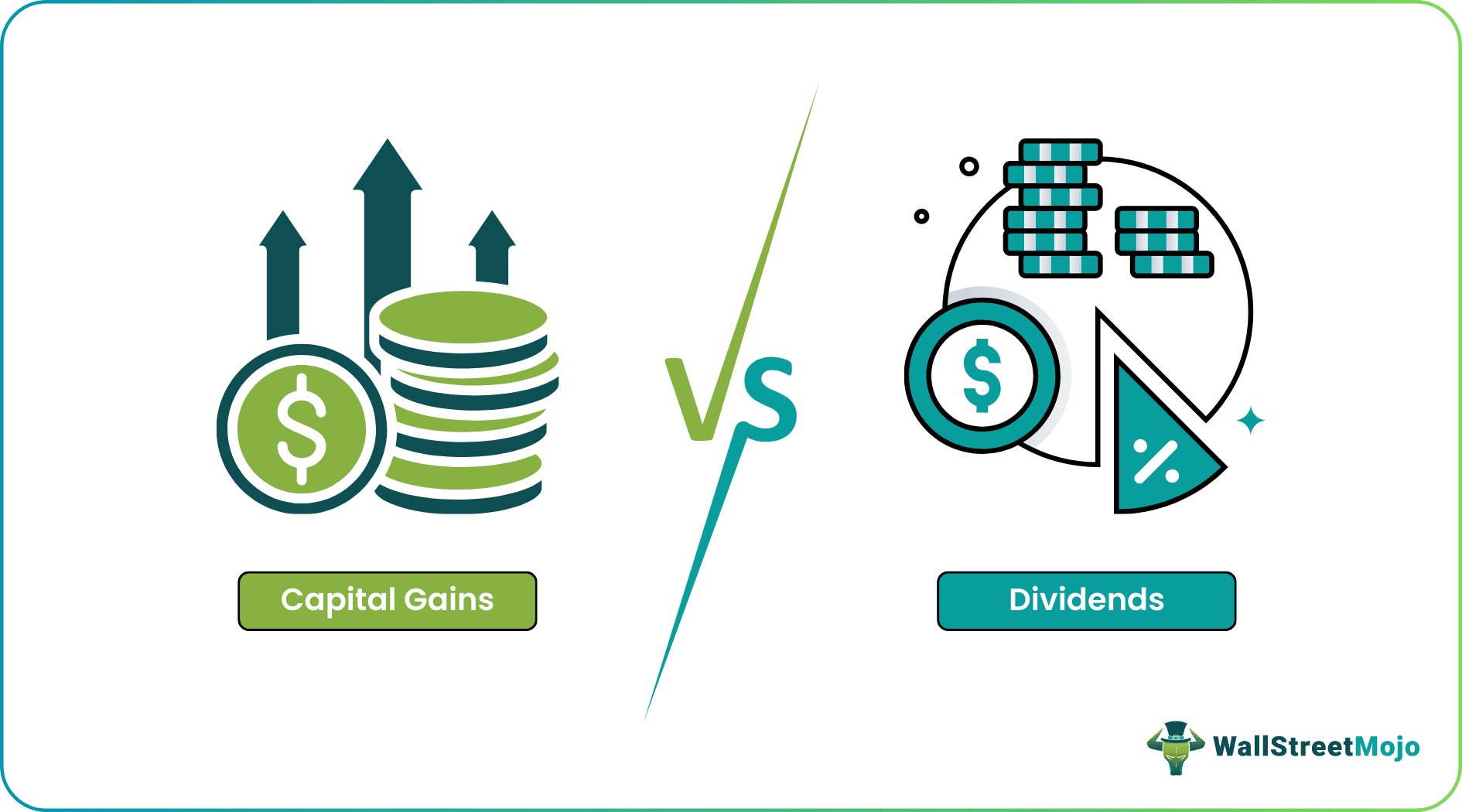Table Of Contents
Difference Between Capital Gains and Dividends
Capital gains are the gains which are realized when a capital asset is sold at a price which is higher than the cost which increase the profits of the company whereas dividend is any payment received from company which the company pays out of profits to its shareholders and which reduces the retained profits of the company.
They are two different forms of income that an investor earns over investments made in the Real estate (Capital gains) or Stocks (Dividends).

Capital gain is a rise in the value of the investment or real estate, which gives it a higher worth than the purchase price. This gain is not realized until the asset is sold. The dividend, on the other hand, is a portion of the earnings of a firm which is distributed to the shareholders as a reward. Let us analyze the differences between capital gains vs. dividends.
Capital Gains vs. Dividends Infographics
Let's see the top differences between capital gains vs. dividends.

Key Differences
- Capital gain is the profit realized after selling off a long-term asset, whereas a dividend is an income received from a company's profits for the stakeholders.
- The occurrence of capital gain requires converting the share/asset into cash, whereas dividends can provide steady periodical income.
- The beneficiaries of capital gains are restricted to the owners and investors, generally few in numbers. However, the beneficiaries of dividends are usually enormous, which can run into thousands depending on the number of shares issued.
- Capital gains are taxed differently depending on if it’s long-term or short-term, whereas dividend is usually charged at a flat rate (e.g., 10%, 15%).
- Capital gains will generally occur once in the investor's lifetime since the value is received upon realization. In contrast, Dividends can be distributed yearly depending on the decision-making and policies of the company's senior management.
- Capital gain is generally on an increasing trend since it's a long-term asset influenced by multiple macroeconomic factors. In contrast, the number of dividends can be erratic and depends on the company's performance and the management's decisions. It may be possible that they have had sufficient returns but may want to plow back an amount from the profits for investing in other firm activities.
- The decision to realize the capital gain rests in the hands of the owners/investors, but shareholders cannot control the timing and the number of dividends to be distributed.
- In terms of payments, capital gains do not offer anything additional apart from the fluctuations in the gain. Still, dividends can offer more in bonus shares, stock splits, etc.
Example
Let’s say if a property is purchased for $2,00,000 and if it’s sold for $2,75,000, the amount of capital gains shall be . The amount of taxation on the same will vary upon the period if it has been held. Say the asset has been sold after three years at a tax rate of 20%. The amount of tax shall be
The tax treatment of capital gains can help reduce the taxable income in a given year. If one has lost money on an investment and is considering changing investment strategy, the asset can be sold at a loss and receive a tax benefit from the losses incurred on the asset. It is never the primary reason to sell.
If a firm declares dividends @ $1.50 per share, it will be multiplied by the number of shares held. Say Mr. A. is holding 12 shares of the firm, then he will get a dividend = 12*1.50 = $18. It is to be noted that dividends may face double taxation since it is already taxed at the corporate level. Further shareholders are also charged dividend distribution tax at an individual level.
Capital Gains vs Dividends Video Explanation
Capital Gains vs. Dividends Comparative Table
| Basis of Comparison | Capital Gains | Dividend |
|---|---|---|
| 1. Meaning | Increase in the value of a Long-term asset | Part of the earnings distributed to shareholders |
| 2. Necessity | It depends on the macroeconomic factors | The depends on the decisions of the senior management |
| 3. Investment | A large investment is required for acquiring the capital asset to be eligible for capital gains. | Relatively less investment for purchasing stocks |
| 4. Taxation | The high amount of tax. | The lower amount of tax is charged. |
| 5. Frequency | Realized upon liquidation | On a periodical basis, depending on policies. |
Conclusion
The objective is to offer income to the investors on the principal amount. Since the amount earned can be volatile, it will attract the attention of the tax authorities and thus is required to be treated cautiously and in line with the investment objectives.
Both have a unique treatment in the U.S. tax code, and knowledge of incorporating these differences within the financial plan will help to utilize the money efficiently in the long run. They can also help tackle tax liabilities and reduce taxable income.
